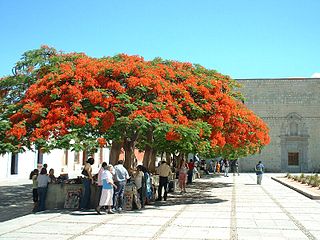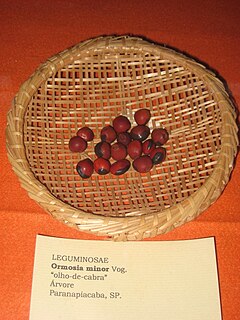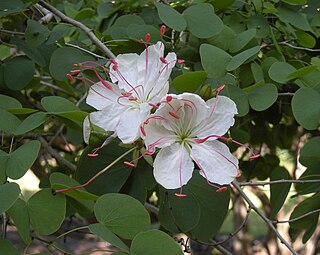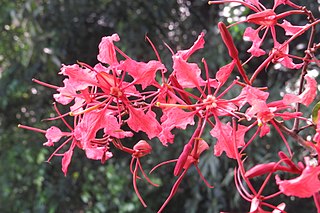
Caesalpinioideae is a botanical name at the rank of subfamily, placed in the large family Fabaceae or Leguminosae. Its name is formed from the generic name Caesalpinia. It is known also as the peacock flower subfamily. The Caesalpinioideae are mainly trees distributed in the moist tropics, but include such temperate species as the honeylocust and Kentucky coffeetree. It has the following clade-based definition:
The most inclusive crown clade containing Arcoa gonavensisUrb. and Mimosa pudicaL., but not Bobgunnia fistuloides(Harms) J. H. Kirkbr. & Wiersema, Duparquetia orchidaceaBaill., or Poeppigia proceraC.Presl

Dalbergia is a large genus of small to medium-size trees, shrubs and lianas in the pea family, Fabaceae, subfamily Faboideae. It was recently assigned to the informal monophyletic Dalbergia clade : the Dalbergieae. The genus has a wide distribution, native to the tropical regions of Central and South America, Africa, Madagascar and southern Asia.

Cassia is a genus of flowering plants in the legume family, Fabaceae, and the subfamily Caesalpinioideae. Species are known commonly as cassias. Cassia is also the English common name of some species in the genus Cinnamomum of the family Lauraceae. Species of the genera Senna and Chamaecrista were previously included in Cassia. Cassia now generally includes the largest species of the legume subtribe Cassiinae, usually mid-sized trees.

The plant tribe Phaseoleae is one of the subdivisions of the legume subfamily Faboideae, in the unranked NPAAA clade. This group includes many of the beans cultivated for human and animal food, most importantly from the genera Glycine, Phaseolus, and Vigna.

The subfamily Detarioideae is one of the subdivisions of the plant family Fabaceae (legumes). This subfamily includes many tropical trees, some of which are used for timber or have ecological importance. The subfamily consists of 84 genera, most of which are native to Africa and Asia. Pride of Burma and tamarind are two of the most notable species in Detarioideae. It has the following clade-based definition:
The most inclusive crown clade containing Goniorrhachis marginataTaub. and Aphanocalyx cynometroidesOliv., but not Cercis canadensisL., Duparquetia orchidaceaBaill., or Bobgunnia fistuloides(Harms) J. H. Kirkbr. & Wiersema.

Parkia is a genus of flowering plants in the legume family, Fabaceae. It belongs to the subfamily Mimosoideae. Several species are known as African locust bean.

Ormosia is a genus of legumes. The more than 100 living species, mostly trees or large shrubs, are distributed throughout the tropical regions of the world, some extending into temperate zones, especially in East Asia. A few species are threatened by habitat destruction, while the Hainan Ormosia is probably extinct already.

Cercidoideae is a subfamily in the pea family, Fabaceae. Well-known members include Cercis (redbuds), including species widely cultivated as ornamental trees in the United States and Europe, Bauhinia, widely cultivated as an ornamental tree in tropical Asia, and Tylosema esculentum, a traditional food crop in Africa. The subfamily occupies a basal position within the Fabaceae and is supported as monophyletic in many molecular phylogenies. At the 6th International Legume Conference, the Legume Phylogeny Working Group proposed elevating the tribe Cercidae to the level of subfamily within the Leguminosae (Fabaceae). The consensus agreed to the change, which was fully implemented in 2017. It has the following clade-based definition:
The most inclusive crown clade containing Cercis canadensisL. and Bauhinia divaricataL. but not Poeppigia proceraC.Presl, Duparquetia orchidaceaBaill., or Bobgunnia fistuloides(Harms) J.H.Kirkbr. & Wiersema.

Lysiphyllum is a genus of flowering plants in the legume family, subfamily Cercidoideae and tribe Bauhinieae. It belongs to the subfamily Cercidoideae. It was formerly treated as part of the genus Bauhinia, but recent molecular phylogenetic analysis confirms that Lysiphyllum is a distinct genus from Bauhinia.

The tribe Desmodieae is one of the subdivisions of the plant family Fabaceae. It is composed of two subtribes, Desmodiinae and Lespedezinae. Recent phylogenetics has this tribe nested within tribe Phaseoleae.
Lasiobema is a genus of flowering plants in the legume family, Fabaceae, most of which are lianas. It belongs to the subfamily Cercidoideae. It was recently synonymized with Phanera on the basis of morphology, but this move has been questioned.

Phanera is a genus of flowering plants in the legume family, Fabaceae. It belongs to the subfamily Cercidoideae. This genus differs from Bauhinia in being vines or lianas, generally with tendrils and a lobed rather than spathaceous calyx, and from Schnella in having only three fertile stamens rather than ten, and being native to the Indomalayan realm and the Australasian realm rather than the Americas. The subsection Corymbosae was recently segregated into a new genus, Cheniella. It has been suggested that the genus Lasiobema should be reduced to a section within Phanera.

Schnella is a genus of flowering plants in the legume family, Fabaceae. It belongs to the subfamily Cercidoideae. All of its species are neotropical lianas.

The tribe Caesalpinieae is one of the subdivisions of the plant family Fabaceae: subfamily Caesalpinioideae.

The subfamily Dialioideae is one of the subdivisions of the plant family Fabaceae (legumes). This subfamily includes many tropical trees and shrubs. The subfamily consists of 17 genera, which are widespread throughout the tropics. It has the following clade-based definition:
The most inclusive crown clade containing Poeppigia proceraC.Presland Dialium guianense(Aubl.) Sandwith, but not Cercis canadensisL., Duparquetia orchidaceaBaill., or Bobgunnia fistuloides(Harms) J. H. Kirkbr. & Wiersema
Biancaea is a genus of flowering plants in the legume family, Fabaceae. It belongs to the subfamily Caesalpinioideae and the tribe Caesalpinieae.
Mezoneuron andamanicum is a species of 'cat's claw' lianas, previously placed in the genus Caesalpinia, in the tribe Caesalpinieae. This species is recorded from the Andaman Islands, Indo-China and Malesia, with no subspecies.
Mezoneuron pubescens is a species of 'cat's claw' lianas, previously placed in the genus Caesalpinia, in the tribe Caesalpinieae. This species is recorded from Malesia and Indo-China. with no subspecies.
Mezoneuron hymenocarpum is a species of 'cat's claw' lianas, previously placed in the genus Caesalpinia, in the tribe Caesalpinieae. Records are from: India, Indo-China, Malesia through to Australia, with no subspecies.

Cheniella is a genus of flowering plants in the legume family, Fabaceae. It belongs to the subfamily Cercidoideae. This genus differs from Phanera in having a hypanthium that is equal in length or longer than the sepals, indehiscent fruit, many-seeded fruit, and the funicle extending most of the circumference of the seed.















